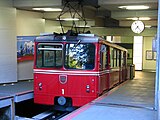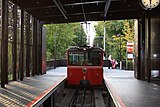Dolderbahn
| Dolderbahn | |
|---|---|
 Dolderbahn railcar No. 1 between Waldhaus Dolder and Bergstation | |
| Overview | |
| Status | In operation |
| Owner | Dolderbahn-Betriebs AG (since 1973); Dolderbahn-Aktiengesellschaft |
| Locale | Zürich, Switzerland |
| Coordinates | 47°22′20″N 8°34′00″E / 47.372132°N 8.566792°E |
| Termini | |
| Stations | 4 (including Titlisstrasse, Waldhaus) |
| Website | stadt-zuerich.ch |
| Service | |
| Route number | 732 |
| Operator(s) | Verkehrsbetriebe Zürich |
| History | |
| Opened | 1895 (as funicular) 1973 (as rack railway) |
| Technical | |
| Number of tracks | 1 with passing loop |
| Rack system | von Roll |
| Track gauge | 1,000 mm (3 ft 3+3⁄8 in) metre gauge |
| Electrification | 600 V, DC, overhead line |
| Highest elevation | 606 m (1,988 ft) |
| Maximum incline | 19.6% |
The Dolderbahn (Db or DBZ) is a 1.3 km (0.81 mi) long rack railway in the Swiss city of Zürich. The line is in Zürich's Hottingen and Fluntern suburbs on the south slope of the Adlisberg mountain. The lower terminus of the line is at Römerhof, some 1.5 km (0.93 mi) from the city centre, where it connects with lines 3 and 8 of the Zürich tramway. The upper terminus at Bergstation Dolderbahn is adjacent to the Dolder Grand Hotel and the Dolder recreation area. Two intermediate stations, at Titlisstrasse and Waldhaus Dolder, are also served.[1][2][3]
The line is owned by the Dolderbahn-Betriebs AG, which is itself 50% owned by the city of Zürich, and is operated on their behalf by the municipal transport operator Verkehrsbetriebe Zürich. The line was opened in 1895 as a funicular railway, and converted to rack operation in 1973. Because of this history, it is still sometimes erroneously referred to as a funicular or cable car.[4]
History[edit]
The first proposal for the line was in 1890, when Heinrich Hürlimann purchased land in the area, although his first proposals fell through. In 1893, the Dolderbahn-Aktiengesellschaft company was formed to build the line, with construction commencing the following year. The line was built as a funicular railway and opened in 1895. The upper terminus of the funicular was roughly on the site of the uppermost of the current line's two intermediate stations. The funicular had a length of 816 metres (2,677 ft) and overcame a height difference of 100 metres (328 ft) with a maximum gradient of 18%.[5][6][7]
Following the opening of the line, a restaurant was built at the line's upper terminus; this became the Dolder Waldhaus Hotel in 1906. In 1899, the Dolder Grand Hotel was built uphill from the upper terminus of the funicular, and was linked to the funicular by a short electric tramway, with a single tramcar. The line was built to the same 1,000 mm (3 ft 3+3⁄8 in) gauge as Zürich's other electric tramways, but was never connected to any of them. In 1922 the tramcar was rebuilt to allow one-man operation, but in 1930 it was replaced by a bus.[8]
In 1971 the concession of the original company expired, and a new company, the Dolderbahn-Betriebs-AG, was created to convert the line to rack operation. At the same time the line was extended at its upper end to directly serve the Dolder Grand Hotel, thus replacing the bus that had in turn replaced the tram. The new line opened in 1973, and in 1999 the Verkehrsbetriebe Zürich took over operation of the line. In 2004, the line was completely renovated along with the four stations and two railcars. As part of this rebuild, a new design of flexible rack turnout was installed at the passing point.[5]
Operation[edit]
The line is 1.3 km (0.81 mi) long and overcomes a height difference of 162 m (531.5 ft). It is built to metre gauge (3 ft 3+3⁄8 in gauge), uses the Strub rack system and is single track with a single intermediate passing loop. The passing loop is situated between Titlisstrasse and Waldhaus Dolder stations and features flexible rack turnouts at both ends.[2][4][9]
The line is operated by a pair of four-wheel rack railcars, each of which can carry 100 passengers. The cars are electrically driven off a 600 volt direct current overhead supply and are propelled by a cog-wheel attached to the downhill of the vehicles two axles. They were built by the Swiss Locomotive and Machine Works, with electrical equipment from Brown, Boveri & Cie, in 1972. In line with its funicular origins, the line has no depot and no track connection to any other line. The cars are stabled and maintained in the terminal stations.[1][4][6]
The line runs from 06.20 until 23.30 every day, with services running every 10, 15 or 20 minutes depending on the time of day. The journey time is approximately 5 minutes. The standard Zürcher Verkehrsverbund zonal fare tariffs apply, with the whole of the line being within fare zone 110 (Zürich city, formerly zone 10).[2][10][11]
Gallery[edit]
-
Römerhof, the lower terminus
-
Dolderbahn railcar No. 1 in the lower terminus
-
Railcar No. 2 at the intermediate passing loop, showing unusual flexible point system
-
Railcar No. 2 in the upper terminus
-
Railcar No. 1 at Titlisstrasse
Future[edit]
In June 2021, the Verkehrsbetriebe Zürich ordered two new railcars from Stadler Rail at Bussnang to replace the existing pair of cars used on the line. The new railcars are scheduled to be delivered in mid-2024 and will cost SFr10.6m. They will feature step-free access with a smaller gap from the platforms than the current vehicles, and two wheelchair spaces.[4][12]
See also[edit]
- List of funicular railways
- List of funiculars in Switzerland
- List of rack railways
- List of Swiss rack railways
References[edit]
- ^ a b Eisenbahnatlas Schweiz. Verlag Schweers + Wall GmbH. 2012. p. 65. ISBN 978-3-89494-130-7.
- ^ a b c "Dolderbahn" (in German). Verkehrsbetriebe Zürich. Archived from the original on 15 November 2011. Retrieved 25 August 2011.
- ^ "Directions". The Dolder Grand. Archived from the original on 12 September 2017. Retrieved 12 September 2017.
- ^ a b c d "Rack railcars ordered for the Dolderbahn". Railway Gazette International. 17 June 2021. Archived from the original on 17 June 2021. Retrieved 17 June 2021.
- ^ a b "Geschichte der Dolderbahn" [History of the Dolderbahn] (in German). Verkehrsbetriebe Zürich. Archived from the original on 24 March 2012. Retrieved 25 August 2011.
- ^ a b "Die Dolderbahn" [The Dolderbahn] (in German). Zürich Tram Museum. Archived from the original on 10 June 2009. Retrieved 26 August 2011.
- ^ Allen, Cecil J. (1958). Switzerland's Amazing Railways. London: Thomas Nelson and Sons. p. 175.
- ^ "Das Doldertram der Dolderbahn" [The tram of the Dolderbahn] (in German). Zürich Tram Museum. Archived from the original on 7 July 2011. Retrieved 26 August 2011.
- ^ "Dolderbahn". Funiculars.net. Pantograph.se. Archived from the original on 30 September 2011. Retrieved 26 August 2011.
- ^ "Online Timetable - Route 25" (PDF). Zürcher Verkehrsverbund. Archived (PDF) from the original on 12 September 2017. Retrieved 12 September 2017.
- ^ "Frequently asked questions". Zürcher Verkehrsverbund. Archived from the original on 3 October 2011. Retrieved 26 August 2011.
- ^ "Dolderbahn rack railcar design unveiled". Railway Gazette International. 19 July 2022. Archived from the original on 17 April 2023. Retrieved 17 April 2023.
External links[edit]
 Media related to Dolderbahn at Wikimedia Commons
Media related to Dolderbahn at Wikimedia Commons- Video of ascent of the line from YouTube





